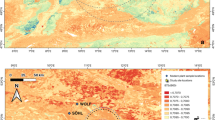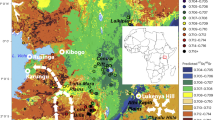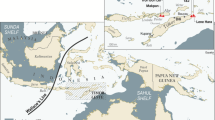Abstract
The dichotomy between early Homo and Paranthropus is justified partly on morphology1,2. In terms of diet, it has been suggested that early Homo was a generalist but that Paranthropus was a specialist3. However, this model is challenged and the issue of the resources used by Australopithecus, the presumed common ancestor, is still unclear. Laser ablation profiles of strontium/calcium, barium/calcium and strontium isotope ratios in tooth enamel are a means to decipher intra-individual diet and habitat changes. Here we show that the home range area was of similar size for species of the three hominin genera but that the dietary breadth was much higher in Australopithecus africanus than in Paranthropus robustus and early Homo. We also confirm that P. robustus relied more on plant-based foodstuffs than early Homo. A South African scenario is emerging in which the broad ecological niche of Australopithecus became split, and was then occupied by Paranthropus and early Homo, both consuming a lower diversity of foods than Australopithecus.
This is a preview of subscription content, access via your institution
Access options
Subscribe to this journal
Receive 51 print issues and online access
$199.00 per year
only $3.90 per issue
Buy this article
- Purchase on SpringerLink
- Instant access to full article PDF
Prices may be subject to local taxes which are calculated during checkout



Similar content being viewed by others
References
Wood, B. Reconstructing human evolution: Achievements, challenges, and opportunities. Proc. Natl Acad. Sci. USA 107, 8902–8909 (2010)
Kay, R. F. & Grine, F. E. in Evolutionary History of the “Robust” Australopithecines (ed. Grine, F. E. ) 427–447 (Aldine de Gruyter, 1988)
Wood, B. & Strait, D. Patterns of resource use in early Homo and Paranthropus . J. Hum. Evol. 46, 119–162 (2004)
Balter, V. Allometric constraints on Sr/Ca and Ba/Ca partitioning in terrestrial mammalian trophic chains. Oecologia 139, 83–88 (2004)
Sponheimer, M. & Lee-Thorp, J. A. Enamel diagenesis at South African Australopith sites: Implications for paleoecological reconstruction with trace elements. Geochim. Cosmochim. Acta 70, 1644–1654 (2006)
Hobson, K. A. Tracing origins and migration of wildlife using stable isotopes: a review. Oecologia 120, 314–326 (1999)
Balter, V. et al. Analysis of coupled Sr/Ca and 87Sr/86Sr variations in enamel using laser-ablation tandem quadrupole-multicollector ICPMS. Geochim. Cosmochim. Acta 72, 3980–3990 (2008)
Humphrey, L. T., Dean, M. C., Jeffries, T. E. & Penn, T. E. M. Unlocking evidence of early diet from tooth enamel. Proc. Natl Acad. Sci. USA 105, 6834–6839 (2008)
Télouk, P., Rose-Koga, E. & Albarède, F. Preliminary results from a new 157nm laser ablation ICP-MS instrument: new opportunities in the analysis of solid samples. Geostand. Newsl. 27, 5–11 (2003)
Kohn, M. J., Schoeninger, M. J. & Barker, W. W. Altered states: effects of diagenesis on fossil tooth chemistry. Geochim. Cosmochim. Acta 63, 2737–2747 (1999)
Balter, V. et al. U-Pb dating of fossil enamel from the Swartkrans Pleistocene hominid site, South Africa. Earth Planet. Sci. Lett. 267, 236–246 (2008)
Copeland, S. R. et al. Strontium isotope evidence for landscape use by early hominins. Nature 474, 76–78 (2011)
Prohaska, T. et al. Investigation of Sr isotope ratios in prehistoric human bones and teeth using laser ablation ICP-MS and ICP-MS after Rb/Sr separation. J. Anal. At. Spectrom. 17, 887–891 (2002)
Kang, D. et al. Application of laser ablation–inductively coupled plasma-mass spectrometry (LA–ICP–MS) to investigate trace metal spatial distributions in human tooth enamel and dentine growth layers and pulp. Anal. Bioanal. Chem. 378, 1608–1615 (2004)
Dolphin, A. E. et al. Variation in elemental intensities among teeth and between pre- and postnatal regions of enamel. Am. J. Phys. Anthropol. 128, 878–888 (2005)
Grün, R., Aubert, M., Joannes-Boyau, R. & Moncel, M. H. High resolution analysis of uranium and thorium concentration as well as U-series isotope distributions in a Neanderthal tooth from Payre (Ardèche, France) using laser ablation ICP-MS. Geochim. Cosmochim. Acta 72, 5278–5290 (2008)
Hinz, E. A. & Kohn, M. J. The effect of tissue structure and soil chemistry on trace element uptake in fossils. Geochim. Cosmochim. Acta 74, 3213–3231 (2010)
Jackson, S. E. & Günther, D. The nature and sources of laser induced isotopic fractionation in laser ablation-multicollector-inductively coupled plasma-mass spectrometry. J. Anal. At. Spectrom. 18, 205–212 (2003)
McHenry, H. M. Relative cheek-tooth size in Australopithecus . Am. J. Phys. Anthropol. 64, 297–306 (1984)
Sponheimer, M. & Lee-Thorp, J. A. Isotopic evidence for the diet of an early hominid, Australopithecus africanus . Science 283, 368–370 (1999)
Laden, G. & Wrangham, R. The rise of the hominids as an adaptive shift in fallback foods: Plant underground storage organs (USOs) and australopith origins. J. Hum. Evol. 49, 482–498 (2005)
Wolpoff, M. H. Posterior tooth size, body size, and diet in South African gracile australopithecincs. Am. J. Phys. Anthropol. 39, 375–393 (1973)
Scott, R. S. et al. Dental microwear texture analysis shows within species diet variability in fossil hominins. Nature 436, 693–695 (2005)
Berger, L. R. et al. Australopithecus sediba: a new Species of Homo-like australopith from South Africa. Science 328, 195–204 (2010)
Hinners, T. A. et al. Interlaboratory comparison of mass spectrometric methods for lead isotopes and traces elements in NIST SRM 1400 Bone Ash. J. Anal. At. Spectrom. 13, 963–970 (1998)
Schweissing, M. M. & Grupe, G. Stable strontium isotopes in human teeth and bone: a key to migration events of the late Roman period in Bavaria. J. Archaeol. Sci. 30, 1373–1383 (2003)
Acknowledgements
The authors thank F. Albarède, J. Blichert-Toft, B. Bourdon and G. Escarguel for helpful comments on the manuscript. This work was supported by the South African National Research Foundation, the French Ministry of Foreign Affairs, the French Embassy in South Africa through the Cultural and Cooperation Services, and the French Institut National des Sciences de l'Univers through the programs ECLIPSE II and PALEO2. The authors are grateful to S. Potze and the Ditsong National Museum of Natural History (formerly Transvaal Museum, Northern Flagship Institution), and the South African Heritage Resources Agency for facilitating access to the fossil samples.
Author information
Authors and Affiliations
Contributions
V.B., J.B. and J.F.T. designed the study, V.B. and P.T. carried out the analysis, V.B. wrote the manuscript with J.B. and J.F.T. All authors discussed the results.
Corresponding author
Ethics declarations
Competing interests
The authors declare no competing financial interests.
Supplementary information
Supplementary Information
This file contains Supplementary Tables 1-3 and a Supplementary Appendix that contains Supplementary Text, Supplementary Table S1, and Supplementary Data. (PDF 11632 kb)
Rights and permissions
About this article
Cite this article
Balter, V., Braga, J., Télouk, P. et al. Evidence for dietary change but not landscape use in South African early hominins. Nature 489, 558–560 (2012). https://doi.org/10.1038/nature11349
Received:
Accepted:
Published:
Issue Date:
DOI: https://doi.org/10.1038/nature11349
This article is cited by
-
Dietary strategies of Pleistocene Pongo sp. and Homo erectus on Java (Indonesia)
Nature Ecology & Evolution (2023)
-
Tracing the mobility of a Late Epigravettian (~ 13 ka) male infant from Grotte di Pradis (Northeastern Italian Prealps) at high-temporal resolution
Scientific Reports (2022)
-
The Reinforcing Natures of Hyper-Palatable Foods: Behavioral Evidence for Their Reinforcing Properties and the Role of the US Food Industry in Promoting Their Availability
Current Addiction Reports (2022)
-
Monthly mobility inferred from isoscapes and laser ablation strontium isotope ratios in caprine tooth enamel
Scientific Reports (2021)
-
Broad-scale morpho-functional traits of the mandible suggest no hard food adaptation in the hominin lineage
Scientific Reports (2020)



